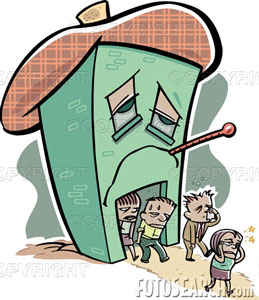Five Steps To Prevent Moldy Buildings
 Problematic moldy buildings are a headache for building owners and managers. Moldy buildings can mean health problems for the building occupants causing them to suffer. They make numerous decisions about design, operation, and maintenance of a building. These decisions are important for the health of the building’s occupants. People suffer when a building is causing health problems.
Problematic moldy buildings are a headache for building owners and managers. Moldy buildings can mean health problems for the building occupants causing them to suffer. They make numerous decisions about design, operation, and maintenance of a building. These decisions are important for the health of the building’s occupants. People suffer when a building is causing health problems.
Building Related Illnesses (BRIs) and Mold Buildings
Building Related Illnesses (BRIs) is the term used to describe illnesses, related to specific exposures in the indoor environment. One of these can be mold.
Mold grows when water/moisture, enters or develops in the building. The entrance of water (incursion) into buildings which are poorly designed or improperly maintained is the main source of mold-associated building-related illness.
In addition, all molds under the right conditions have the potential to cause allergic reactions, infections and mycotoxins. Examples of illnesses related to poorly maintained buildings with mold include:
- Allergic reactions similar to common pollen or animal allergies. Symptoms include sneezing, itchy eyes, nose and throat, a stuffy or runny nose, sore throat, headache and fatigue. Multiple indoor allergens, in addition to mold, can be involved
- Infections which at times include systemic fungal infections
- Mycotoxins are metabolic by products produced by some molds which can cause toxic reactions in humans. A wide variety of molds, including the most common molds generally considered harmless, are capable of producing mycotoxins
Moldy Buildings Preventive Maintenance
What preventive measures can building owners and managers take to avoid these mold problems?
- Conduct routine visual inspections including regular checks to look for excessive moisture. Such things as high humidity, water intrusions, water leaks, improper venting, poor drainage and poor maintenance contribute to excessive moisture. Keeping relative humidity below 50% is the goal. Low humidity minimizes mold growth
- Prevent mold and bacterial growth in the building’s ventilation system by regular inspections
- Follow the suppliers recommended maintenance schedules for all ventilation equipment
- Prevent microbial growth and the entry of other problematic microorganism or chemicals through the ventilation system by rigorous maintenance and cleaning
- Maintain and clean the air ducts and correct any deficiencies
Finally, remember the impact of building moisture. If building moisture is left unattended mold will start to grow within 72 hours of a water intrusion event. This is also true if a humidity problem is left unattended.
TKEC is one of few local companies to conduct indoor air quality and mold sampling investigations and have a Certified Microbial Remediation Supervisor (CMRS) on staff.


